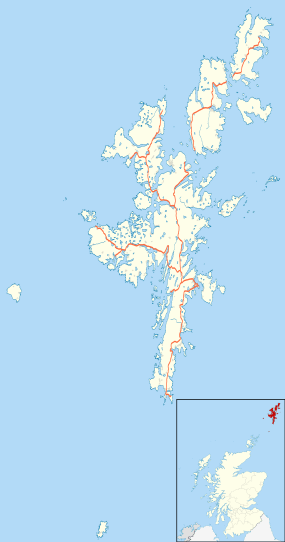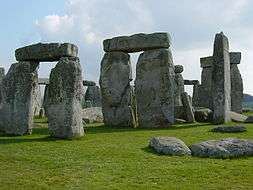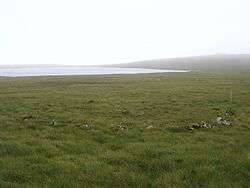Hjaltadans
| Hjaltadans | |
|---|---|
| Native name Fairy Ring | |
|
A picture of the stone circle | |
| Location | Shetland, Scotland |
| Coordinates | 60°36′36.57″N 0°51′49.95″W / 60.6101583°N 0.8638750°WCoordinates: 60°36′36.57″N 0°51′49.95″W / 60.6101583°N 0.8638750°W |
| Built | During the Neolithic Period |
| Architectural style(s) | British pre-Roman Architecture |
 Hjaltadans shown within Shetland | |
Hjaltadans, also known as Fairy Ring or Haltadans stone circle, is a stone circle on the island of Fetlar in Shetland, Scotland.[1] This site is a ring of 38 stones,[2] of which 22 are still fixed in the soil, and it is 11 metres (37 ft) in diameter.[3] Inside this is an earthen ring 7.9 metres (26 ft) in diameter, with a 1.5 metres (5 ft) gap in the southwest side.[1] In the center of the rings are two rectangular pillars.[1][3]
According to J. Jakobsen, the name Haltadans means: "lame or limping dance".[4] This is a reference to the legend that the circle of stones was once a circle of dancing trolls and that the two rock pillars in the center were once a fiddler and his wife.[3] They had fiddled and danced all night long, and, heedless of the time, were still fiddling and dancing when the sun rose and petrified them all.[2]
See also
 Archaeology portal
Archaeology portal
References
- 1 2 3 "Hjaltadans". Stone Circle in Scotland in Shetland. Megalithic Portal. Retrieved 12 December 2010.
- 1 2 Smith, Hamish Haswell (16 May 1998). "Fetlar Island of the Week". Scotland Herald. Retrieved 12 December 2010.
- 1 2 3 "Fetlar, Gravins, 'Haltadans'". Canmore Site Records. Royal Commission on the Ancient and Historical Monuments of Scotland. Retrieved 12 December 2010.
- ↑ Jakobsen, J. (1897). The Dialect and Place-Names of Shetland. pp. 116–117.
